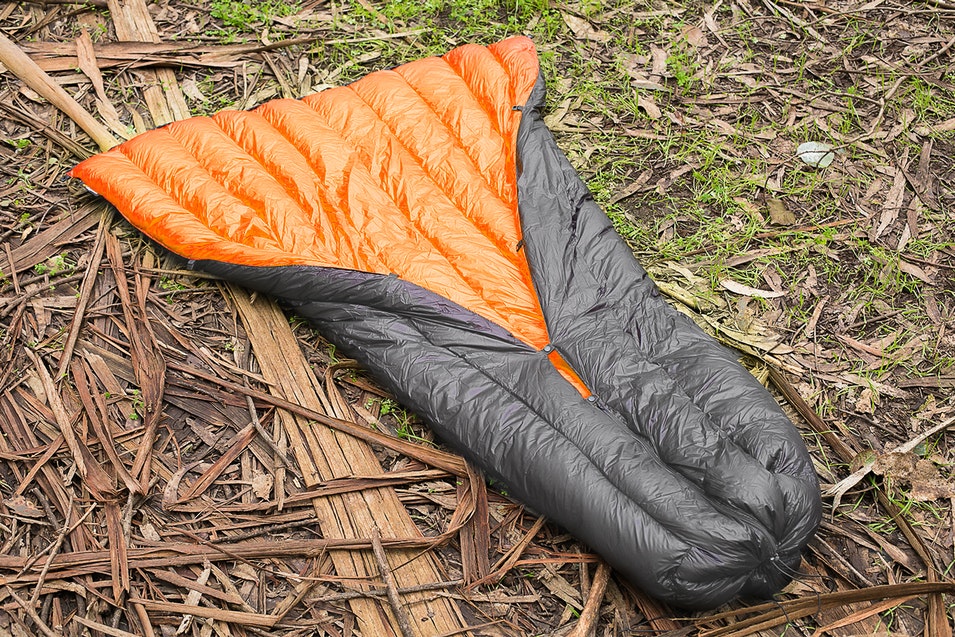Backcountry adventure and cuisine for aspiring hiker trash
Lose Weight With a Quilt

PACK weight, not body weight!
The vast majority of new backpackers use sleeping bags, and why not? After all, that’s what everybody has always used, right? I used to be one of those people too, until I learned about backpacking quilts.
The premise behind “quilting” is that the down beneath you in a sleeping bag is basically useless. You’re laying on it and compressing it, thereby negating its insulating capabilities….so why have it there in the first place? A quilt removes the bottom from the equation, and saves weight in the process.
Using a quilt also gives you more flexibility in regulating your body temperature. Suppose you brought a 20 degree sleeping bag on a shoulder season hike, but it’s unexpectly warm and let’s say it only gets down to 45 degrees one night. You’re going to cook in your bag, but all you can do to mitigate that is to unzip it and ventilate a little bit (in most cases) whereas with a quilt you can just open it up and use it like a blanket, as loosely as you like.
Now, using a quilt down to its temperature rating is just a little bit more fussy than using a sleeping bag. If you don’t keep the edges tucked in, you can suffer from the dreaded drafts. Most of the major quilt manufacturers get around this with strap systems that keep the edges of your quilt properly positioned on the pad. This allows you to roll from side to side during the night without getting drafts. Try rolling side to side in your sleeping bag and tell me how that works out for you.
So, about those weight savings….let’s use a couple of personal examples.
My main shoulder season quilt is an Enlightened Equipment Revelation 30 degree long/wide which weighs just under 20 oz. A high quality equivalent down bag such as a Western Mountaineering Megalite or Feathered Friends Kestrel weighs 5 or 9 oz. more respectively.

You will notice that the EE quilt has a small zipper and drawstring to allow creation of a footbox. If it’s too warm for that, simply undo them and open the quilt up like a blanket.
My workhorse winter quilt is a Katabatic Gear Sawatch 15 degree long/wide in 850fp down. It weighs 31 oz. The comparable sleeping bag (a Western Mountaineering Badger) weighs 9 oz. more. And there’s an even greater weight difference if you’re using another manufacturer’s bags.

The other quilts in my arsenal are an EE 40 degree synthetic quilt for warmer weather hikes in the humid southeast, and a Katabatic 22 degree Flex quilt that sees occasional use in cold places when it’s not winter. I used it for example in the Wind River Range last September.
Quilts weigh less, and take up less pack space. The only potential drawback as I see it, beside potential drafts (an issue that’s NEVER been a problem for me) is that a quilt doesn’t cover your head like a mummy sleeping bag does. That could be an issue when it’s cold. The way around that problem is to wear a beanie or a down hood, or even a balaclava, while you sleep. If it’s cold, you should have one or two of these items in your pack anyway. You may even be using them during the day. Why not use them at night too?
Everyone’s different, but I was comfortable one December in the Smokies in my Sawatch while wearing capilene baselayers only as well as down booties and a beanie down to temperatures as low as 5 degrees.
What would I do if temps could drop as low as zero? Ahhh, another nice thing with quilts is that you can layer them same as your clothes. In this case I would bring my 15 degree Sawatch and my 40 degree EE synthetic quilt, and layer the synthetic quilt over the Sawatch. This gives you (there’s formulas for this) a zero degree sleep system….and any condensation will occur in the outer synthetic quilt, which can handle it better than the down quilt.
There are quite a few quilt makers out there, but IMHO the 2 best are the two brands I own. Enlightened Equipment is very customizable as far as sizing, fabric colors etc. and are quite well made as well as moderately priced. Katabatic isn’t much on customization beyond sizing, but on the other hand they have impeccable quality (and a price to match that is well worth it and still cheaper than a high end sleeping bag).
If the prospect of losing an easy half pound or more of your base weight is intriguing, I suggest purchasing a 30 or 40 quilt and trying it out on a hike that isn’t real cold. Remember, you can always put on extra clothes if you’re chilled. You already have them in your pack.
Remember to have a sleeping pad with an appropriate R rating for your conditions. Whether you’re using a sleeping bag or a quilt, you can lose substantial body height through a pad. It happened to me once and it sucked like this year’s Baltimore Orioles.
Recent Comments